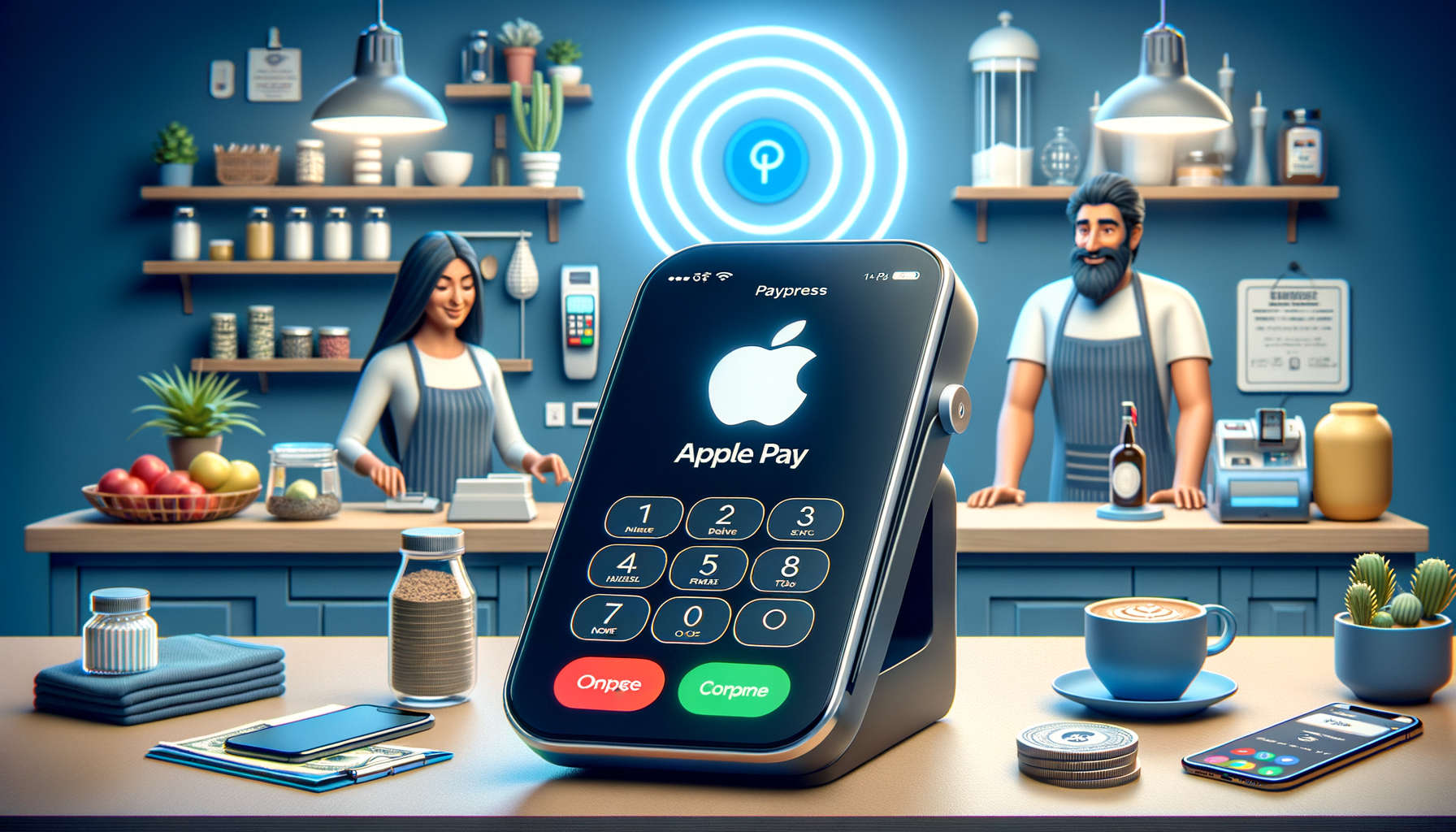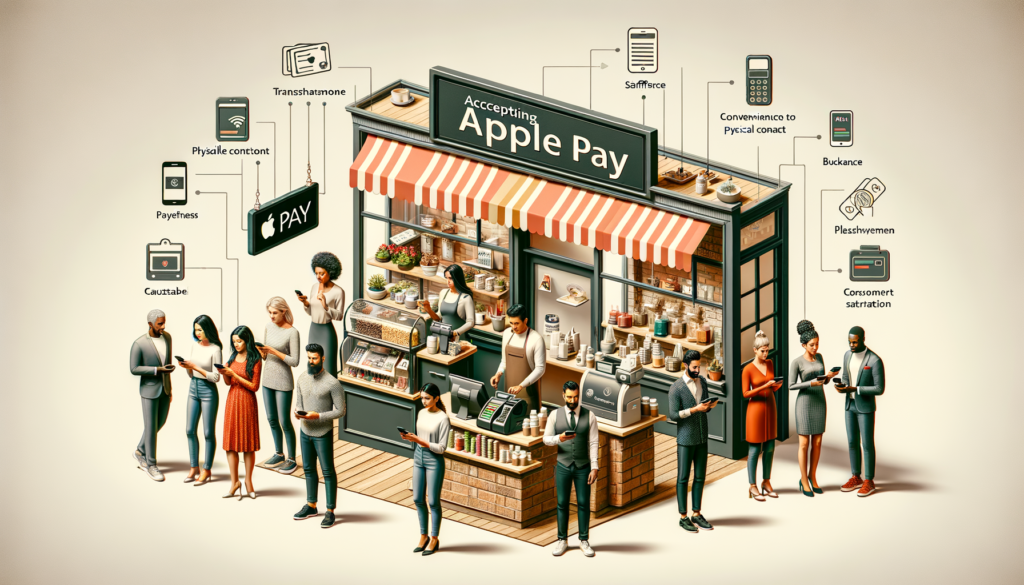
By Harriet Forster October 14, 2024
As technology evolves, consumers are increasingly turning to contactless payment methods like Apple Pay for convenience, speed, and security. For small businesses, accepting Apple Pay can offer a competitive edge by catering to the growing number of customers who prefer this modern payment option. Whether you run a brick-and-mortar store, an e-commerce website, or both, understanding how to accept Apple Pay is essential for keeping up with consumer trends and improving the overall customer experience.
In this comprehensive guide, we’ll cover everything you need to know about Apple Pay, including what it is, how it works, the benefits it brings to your business, how to set it up, security features, and frequently asked questions. By the end of this article, you’ll have a clear understanding of how to successfully implement Apple Pay at your small business.
What is Apple Pay?
Apple Pay is a mobile payment and digital wallet service by Apple Inc. that allows users to make payments in person, online, and through apps using their iPhone, Apple Watch, iPad, or Mac. Instead of using a physical credit card or cash, customers can use their Apple devices to pay by holding their phone near a contactless reader or using Apple Pay online. This technology leverages Near Field Communication (NFC) to enable secure, fast, and contactless transactions.
Apple Pay supports most major credit cards and banks, allowing users to link their payment information to their Apple Wallet app. When a customer uses Apple Pay, their card information is not shared with merchants, which adds an extra layer of security.
Benefits of Accepting Apple Pay at Your Small Business

Adopting Apple Pay comes with several benefits that can significantly improve the way your business operates and interacts with customers. Here are some of the key advantages of accepting Apple Pay at your small business:
1. Faster Transactions
Apple Pay enables quicker checkouts compared to traditional payment methods like cash or credit cards. By simply tapping their iPhone or Apple Watch on a contactless reader, customers can complete transactions in seconds, leading to shorter lines and faster service, especially during peak times.
2. Enhanced Customer Experience
Offering Apple Pay provides convenience for customers who prefer using mobile wallets. It eliminates the need for them to carry physical credit cards, making their shopping experience smoother and more enjoyable. As a result, customers are more likely to return to businesses that provide quick, hassle-free payment options.
3. Increased Security
Security is a major concern for both businesses and customers. With Apple Pay, sensitive card information is not stored on the device or shared with the merchant. Instead, a unique transaction code is generated for each payment, ensuring a secure transaction. This reduces the risk of data breaches, fraud, and identity theft.
4. Attracting Tech-Savvy Customers
Many tech-savvy customers and younger demographics are early adopters of mobile wallets and contactless payments. By offering Apple Pay, your small business can appeal to this growing segment of consumers who are more likely to use businesses that embrace modern technology.
5. Compatibility with E-Commerce
Apple Pay is not limited to in-person transactions; it can also be integrated into your e-commerce website or app. This allows customers to complete online purchases easily and securely, improving your business’s online conversion rates.
6. Improved Hygiene
Especially in the wake of the COVID-19 pandemic, contactless payments like Apple Pay have gained popularity due to their hygienic nature. Customers can avoid touching payment terminals and handling cash, providing a safer option for both parties.
How to Set Up Apple Pay at Your Small Business

Setting up Apple Pay for your small business is a relatively straightforward process. The specific steps will depend on whether you’re accepting payments in person, online, or through an app. Here’s a step-by-step guide for setting up Apple Pay:
1. Check Hardware Compatibility
To accept Apple Pay in your physical store, you need a point-of-sale (POS) terminal that supports contactless payments via NFC technology. Many modern POS systems already include NFC functionality, but if your system is outdated, you may need to upgrade.
If you’re unsure whether your POS terminal supports Apple Pay, check with your payment processor or POS provider. Popular POS systems like Square, Clover, Shopify, and Vend are compatible with Apple Pay and offer easy setup options.
2. Update Your Payment Processor
Ensure that your payment processor supports Apple Pay transactions. Most major payment processors, including Stripe, Square, PayPal, and Braintree, allow Apple Pay integration. If your current processor doesn’t support it, you may need to switch to one that does.
Once your payment processor is compatible, they can provide instructions on enabling Apple Pay on your system. In many cases, it’s as simple as activating the feature through your account dashboard or by contacting customer support.
3. Set Up Apple Pay for In-Person Payments
If your POS system supports NFC technology, you can start accepting Apple Pay for in-person transactions. Here’s how the setup process works:
- Enable Contactless Payments: Work with your payment processor or POS provider to enable contactless payments, including Apple Pay.
- Test the System: After enabling contactless payments, conduct a few test transactions using Apple Pay to ensure everything is functioning properly.
- Train Your Staff: Make sure your employees are familiar with how to process Apple Pay transactions. Since Apple Pay works similarly to traditional contactless payments, staff members should find it easy to manage.
4. Set Up Apple Pay for Online Payments
For businesses with an online store, Apple Pay can be integrated into your website’s checkout process. This requires integrating Apple Pay with your payment gateway or e-commerce platform. Follow these steps:
- Check Platform Compatibility: Platforms like Shopify, WooCommerce, BigCommerce, and Magento support Apple Pay integration. Ensure that your e-commerce platform allows for Apple Pay payments.
- Enable Apple Pay in Your Payment Gateway: Work with your payment gateway provider (e.g., Stripe, Square, PayPal) to enable Apple Pay on your website.
- Test the Checkout Process: Run test transactions to ensure that Apple Pay works smoothly during the checkout process.
5. Set Up Apple Pay for Mobile Apps
If your business has a mobile app, you can allow customers to pay with Apple Pay directly from their smartphones. This is especially useful for businesses with subscription services, mobile orders, or retail apps. To enable Apple Pay in your app:
- Integrate Apple Pay API: Developers will need to integrate Apple Pay’s API into your app. Apple provides documentation and resources to help developers through this process.
- Test Transactions: After integration, test the payment functionality to make sure it works as expected.
Security and Fraud Prevention with Apple Pay

Apple Pay comes with several built-in security features that help protect both merchants and customers. Here’s how Apple Pay enhances security:
1. Tokenization
Instead of transmitting actual card numbers, Apple Pay uses tokenization to replace sensitive data with a unique identifier (token) for each transaction. This means that even if the transaction is intercepted, the attacker cannot access the real credit card information.
2. Biometric Authentication
For transactions made using Apple Pay, customers must authenticate the payment using biometric methods such as Face ID or Touch ID. This ensures that only the authorized user can complete the transaction, reducing the risk of fraud.
3. Device-Specific Numbers
Apple Pay assigns each device a unique Device Account Number, which is stored in the Secure Element of the device. This number is used during transactions and is different from the actual card number, further enhancing security.
4. Two-Factor Authentication
Apple Pay supports two-factor authentication (2FA) for additional protection. This means customers can add an extra layer of security by requiring a second form of verification for payments.
Challenges of Accepting Apple Pay at Small Businesses
While Apple Pay offers many benefits, there are a few challenges small businesses might face when implementing it:
1. Upfront Costs
For businesses that need to upgrade their POS systems to support NFC technology, there may be upfront costs involved. New POS terminals can be an investment, although many POS providers offer flexible payment plans.
2. Customer Awareness
Although Apple Pay is becoming increasingly popular, some customers may not be aware of how it works or may not be comfortable using mobile payments. It may take time to educate customers and encourage them to adopt this payment method.
3. Payment Processing Fees
Like other credit card payments, Apple Pay transactions incur payment processing fees. However, these fees are generally comparable to standard credit card processing fees, so they shouldn’t be a significant drawback.
Frequently Asked Questions (FAQs)
Q1. What devices can customers use to pay with Apple Pay?
Customers can use iPhones (iPhone 6 and later), Apple Watches, iPads, and Macs to make Apple Pay payments. The device must have a compatible operating system and NFC capability for in-person payments.
Q2. How much does it cost to accept Apple Pay?
The cost of accepting Apple Pay is typically included in your payment processor’s transaction fees for credit cards. There are no additional fees specific to Apple Pay, but standard credit card processing fees apply.
Q3. Can I accept Apple Pay for online and in-app purchases?
Yes, you can accept Apple Pay for both online purchases and in-app transactions. Apple provides APIs and integration support to make this process straightforward for businesses.
Q4. Is Apple Pay secure for my small business?
Yes, Apple Pay is considered one of the most secure payment methods due to its tokenization, biometric authentication, and encryption technologies. It significantly reduces the risk of fraud and data breaches.
Q5. Can Apple Pay work with my current payment processor?
Most major payment processors support Apple Pay, including Stripe, Square, PayPal, and Braintree. Check with your payment processor to confirm compatibility and enable Apple Pay if it’s not already activated.
Conclusion
Accepting Apple Pay at your small business offers numerous benefits, from faster transactions and enhanced security to an improved customer experience. As more consumers adopt mobile wallets and contactless payment methods, embracing Apple Pay can help your business stay competitive and cater to tech-savvy customers.
With its straightforward setup process and wide compatibility with major POS systems and e-commerce platforms, adding Apple Pay as a payment option can be a simple yet impactful step for any small business looking to modernize its payment systems.
By understanding the benefits, setting up the necessary infrastructure, and ensuring your team is prepared to handle Apple Pay transactions, your business can unlock a new level of convenience, security, and customer satisfaction.